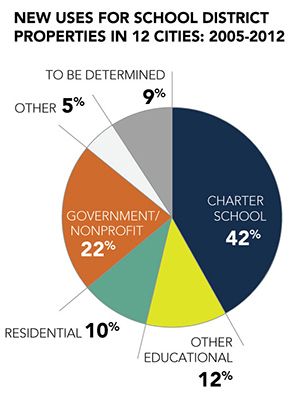Philadelphia and Other Big Cities Struggle to Find Uses for Closed Schools
 Large-scale public school closures have become a fact of life in many American cities, and that trend is not likely to stop now. Shuttered Public Schools: The Struggle to Bring Old Buildings New Life (PDF) looks at what happens to the buildings themselves, studying the experiences of Philadelphia and 11 other cities that have decommissioned large numbers of schools in recent years: Atlanta, Chicago, Cincinnati, Cleveland, Detroit, Kansas City, Mo., Milwaukee, Pittsburgh, St. Louis, Tulsa and Washington.
Large-scale public school closures have become a fact of life in many American cities, and that trend is not likely to stop now. Shuttered Public Schools: The Struggle to Bring Old Buildings New Life (PDF) looks at what happens to the buildings themselves, studying the experiences of Philadelphia and 11 other cities that have decommissioned large numbers of schools in recent years: Atlanta, Chicago, Cincinnati, Cleveland, Detroit, Kansas City, Mo., Milwaukee, Pittsburgh, St. Louis, Tulsa and Washington.
On December 13, 2012, Superintendent William R. Hite Jr. announced tentative plans to shutter 15 percent of Philadelphia's district-run schools, 37 in all, in what would be one of the nation's largest single-year closings. If those plans are adopted, even in pared-down form, the district will have a lengthy list of empty buildings on its hands, on top of those it already has.
The challenge of finding new uses for old buildings is daunting, and the downside of letting them sit idle can be significant. Since 2005, the 12 districts have sold, leased or reused a total of 267 properties and still have 301 unused sites on the market, empty buildings that can cast a pall over their neighborhoods and be costly to seal, maintain and insure. And the act of selling a vacant school building, even at a low price, does not guarantee successful reuse, only a change of ownership.
Some of the districts, including Washington and Cincinnati, have disposed of facilities with relative speed, while others have done less well; and Detroit has had to deal with far more closed schools than any of the others. The differences in performance are due in part to the nature of local real estate markets, the length of time buildings have been empty, and the impact of varying laws and policies that are still evolving.
The research found:
- Sale prices for most shuttered schools have been between $200,000 and $1 million, frequently well below initial projections. In Cincinnati, 11 buildings and one vacant parcel were sold at auction for a total of $3.5 million in 2012, far less than an official valuation. Factors contributing to the relatively low prices include conditions of the buildings, many of which are old, large and decaying; layouts not conducive to new uses; and locations in residential areas suffering from depopulation and decline.
- More than 40 percent of the sold, leased or reused properties have gone to charter schools, and yet there is disagreement over whether this is desirable. Charters are obvious candidates to use the buildings and often have access to the resources needed to acquire them. But the flow of students to charters can further reduce enrollment in district-run schools, exacerbating the situation. Chicago, which once favored charters as occupants, plans to strictly limit the ability of buyers of vacant school properties to use them for charters. Philadelphia's governing School Reform Commission, which has a policy in place offering price discounts for all educational uses, recently gave itself the power to cap charter expansions for five years.
- Housing, both market-rate and subsidized, is also a common reuse. Others include homeless shelters, churches, community centers, and various offices. There are recording studios in Detroit, daycare facilities in St. Louis, and plans for an African American cultural center in Milwaukee and a green technology center in Pittsburgh. Sites where schools once stood will soon become home to a shopping center in Detroit, an apartment building in Cincinnati, and green space in a number of cities.
View our previous study, Closing Public Schools in Philadelphia: Lessons from Six Urban Districts, which looked at a wide range of issues involved in the shuttering of buildings, including the impact on students.
Read the report: Shuttered Public Schools: The Struggle to Bring Old Buildings New Life | Errata


America’s Overdose Crisis
Sign up for our five-email course explaining the overdose crisis in America, the state of treatment access, and ways to improve care
Sign up








